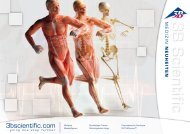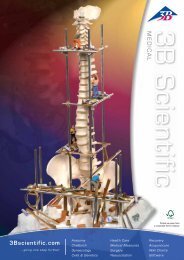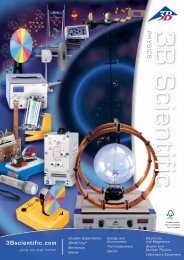3B Scientific - Physics & Engineering Experiments
3B Scientific - Physics & Engineering Experiments
3B Scientific - Physics & Engineering Experiments
Create successful ePaper yourself
Turn your PDF publications into a flip-book with our unique Google optimized e-Paper software.
UE3070700<br />
Electricity / electron tubes<br />
Fine-Beam Tube<br />
UE3070700<br />
BASIC PRINCIPLES<br />
Electrons in a fine-beam tube are deflected into a circular path by a uniform<br />
magnetic field. The tube contains neon gas at a precisely defined<br />
pressure so that gas atoms become ionised by collision with electrons<br />
along the path thus causing them to emit light. This means the path of<br />
the electrons can be viewed directly and the radius of the curvature can<br />
simply be measured with a ruler. Since the accelerating voltage of the<br />
electron gun U and the magnetic field strength B are both known, the<br />
radius of the path r can be used to determine the specific charge of an<br />
electron e/m:<br />
An electron moving at velocity v in a direction perpendicular to a magnetic<br />
field B is subject to a Lorentz-force that acts in a direction orthogonal to<br />
both the movement and the magnetic field:<br />
r<br />
B<br />
F<br />
v<br />
(1)<br />
F = e ⋅v<br />
⋅B<br />
e: Charge on an electron<br />
This gives rise to a centripetal force on the electron<br />
(2)<br />
2<br />
m⋅v<br />
F =<br />
r<br />
m: Mass of an electron<br />
Fig. 1: Deflection of electron of velocity v in a magnetic field B by a Lorentzforce<br />
F into a closed circular path of radius r<br />
EXPERIMENT<br />
PROCEDURE<br />
• Demonstrate the deflection of electrons<br />
in a uniform magnetic field into a<br />
closed circular path.<br />
• Determine the Helmholtz current I H as<br />
a function of the accelerating voltage<br />
of the electron gun U for a constant<br />
path radius r.<br />
OBJECTIVE<br />
Determine the specific charge of an electron<br />
Summary<br />
In the fine-beam tube, the path of electrons in a uniform magnetic field can be observed as a clearly<br />
delineated ray. This means that the radius of the circular path can be directly measured with a simple<br />
ruler. From the path radius r, the magnetic field B and the electron gun’s accelerating voltage U the<br />
specific charge of an electron e/m can be calculated.<br />
such that it moves in a circular path of radius r. Therefore<br />
(3)<br />
The velocity v is dependent on the accelerating voltage U applied to the<br />
electron gun:<br />
(4)<br />
Therefore the specific charge of the electron is given by:<br />
(5)<br />
m⋅v<br />
e ⋅B<br />
=<br />
r<br />
e<br />
v = 2 ⋅ ⋅U<br />
m<br />
e<br />
m<br />
2⋅<br />
U<br />
=<br />
( r ⋅B) 2<br />
required apparatus<br />
Quantity Description Number<br />
1 Fine Beam Tube on Connection Base 1000904<br />
1 Helmholtz Coils 300 mm 1000906<br />
1 DC Power Supply 0 – 500 V (230 V, 50/60 Hz) 1003308<br />
DC Power Supply 0 – 500 V (115 V, 50/60 Hz) 1003307<br />
1 Analogue Multimeter AM50 1003073<br />
1 Set of 15 Safety Experiment Leads, 75 cm 1002843<br />
EVALUATION<br />
The magnetic field B is generated by a pair of Helmholtz-coils and is<br />
proportional to the current I H that passes through each of the coils. The<br />
coefficient of proportionality k can be determined from the coil radius<br />
R = 147.5 mm and the number of turns in the coil N = 124 per coil:<br />
3<br />
⎛ ⎞<br />
N<br />
B = k ⋅I H where k = ⎜<br />
4 2 − Vs<br />
⎟ ⋅ 4π⋅10<br />
7 ⋅<br />
⎝ 5 ⎠<br />
Am R<br />
This means that all the components needed to calculate the specific<br />
change are known.<br />
Fig. 2: Fine-beam tube with spherically-shaped luminous trace of electrons in<br />
the magnetic field<br />
2<br />
160 <strong>3B</strong> <strong>Scientific</strong>® <strong>Experiments</strong><br />
...going one step further<br />
161















